Today I’m sharing some of the best things to do in Takayama, Japan! Located in the northern mountainous region of the Gifu prefecture, Takayama is the gateway to both the Japanese Alps and the famous thatched farmhouses of Shirakawa-go.
Plus, the city is worth a visit in its own right. When you visit Takayama you can walk down the streets of the old Edo district, feast on local cuisine including their world-famous Hida beef, stay in a traditional ryokan, visit countless temples and shrines, and so much more!

We spent a lot of time travelling in Japan’s Golden Triangle (Tokyo, Kyoto and Osaka), however, Takayama was by far one of our favourite destinations and it made us want to venture a bit more off the beaten path during the rest of our travels in the country.
So without further ado, here are some of the best things to do in Takayama on your visit. The following is our Takayama travel guide.
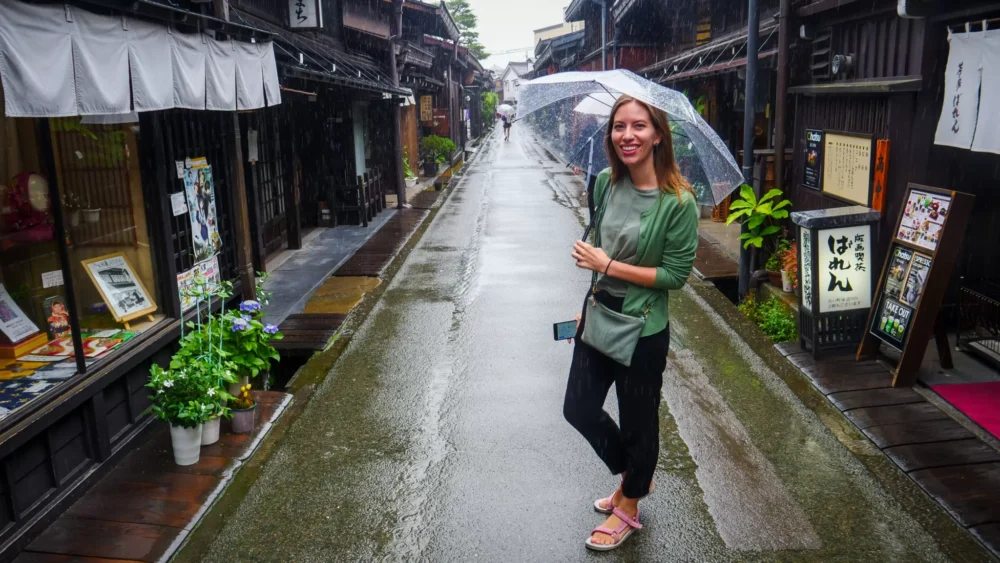
Visiting Takayama soon? Here are your travel essentials! 🇯🇵
Top Takayama Tours ⛩️
Takayama Guided Walking Tour – visit Meiji-era inns and shrines
Food and Sake Tasting – try traditional snacks and sake
Sake Brewery Tour – tour the oldest brewery in the area
Top Takayama Hotels 🛏️
Hotel Wood Takayama – combines modernity with tradition
Ryokan Kaminaka – traditional inn with kaiseki meal option
Takayama Green Hotel – futons on tatami or Western beds
What to Do, See, Eat, Drink & Experience in Osaka, Japan for Visitors
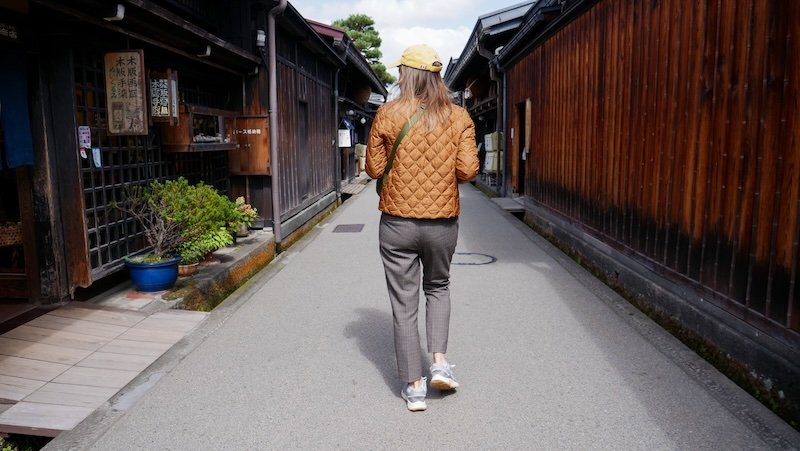
Walk down Sanmachi Suji
Takayama is the kind of place that’s best experienced on foot and Sanmachi Suji is the place to start!
Sanmachi Suji is Takayama’s historic centre and is made up of three streets: Ichi-no-machi, Ni-no-machi and San-no-machi.
This particular part of the city was once a bustling merchant town and today it is considered to be one of the best-preserved Edo districts in all of Japan.
Walking here will make you feel like you’ve been transported through time all the way back to the Edo period which dates from 1603 to 1868.
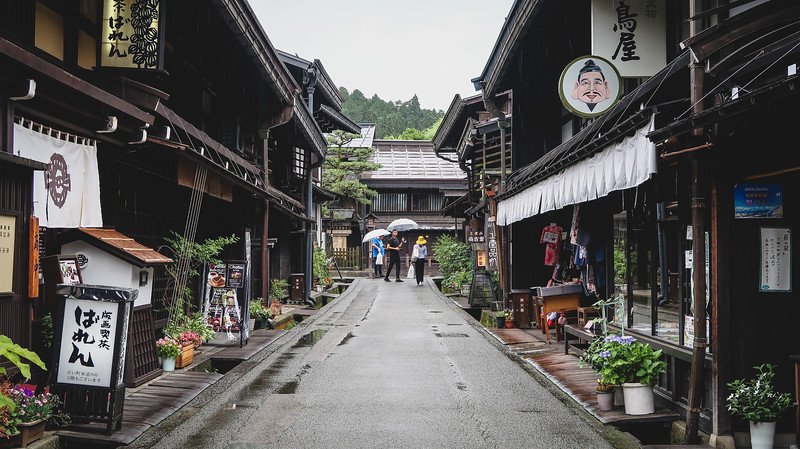

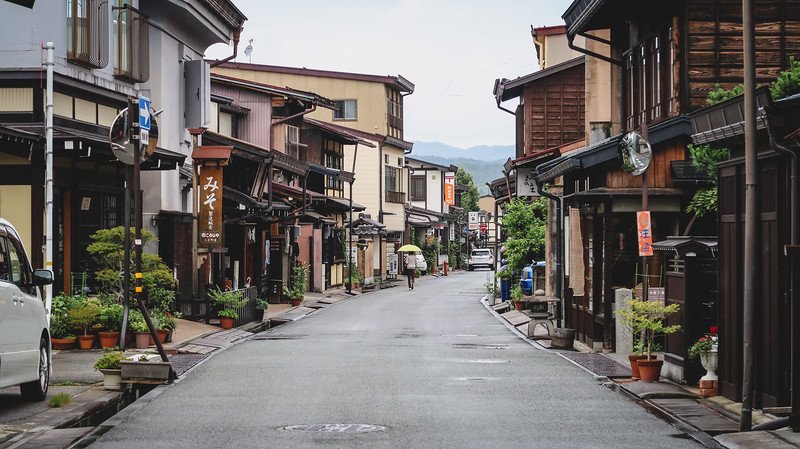
The buildings in Takayama’s old town are painted black just as they would have been during the Edo period, and even though some of the structures are over 300 years old, they are still in use!
The former merchant structures now house a sake brewery, traditional craft shops, and restaurants serving up local specialities like Hida beef and vegetarian cuisine.
Walking through Sanmachi Suji, it’s easy to see why this district has been nicknamed ‘Little Kyoto.
We happened to visit on a rainy day, so we had the streets almost all to ourselves and it felt pretty magical.
Hike the Higashiyama Walking Course
One of the top attractions in Takayama is the Higashiyama Walking Course, which is a path that runs through Takayama’s temple town also known as Teramachi.
The course is 3.5 kilometres in length and it goes past numerous temples and shrines, as well as the ruins of Takayama’s former castle.
It takes about 2 hours to complete the walking course and enjoy the sights along the way.
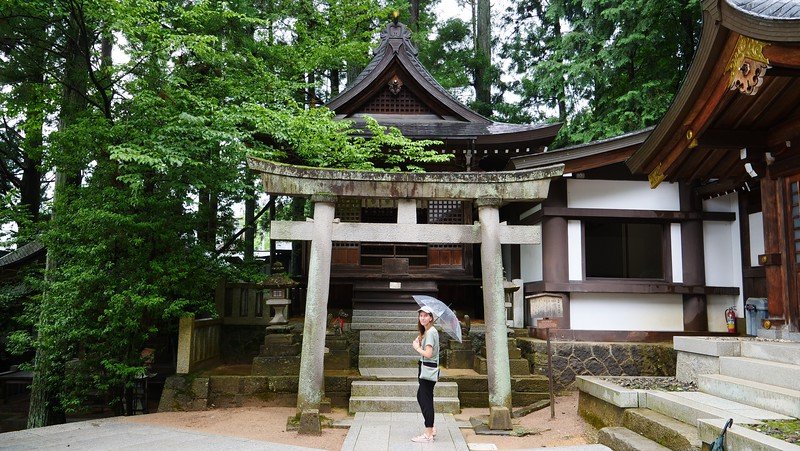
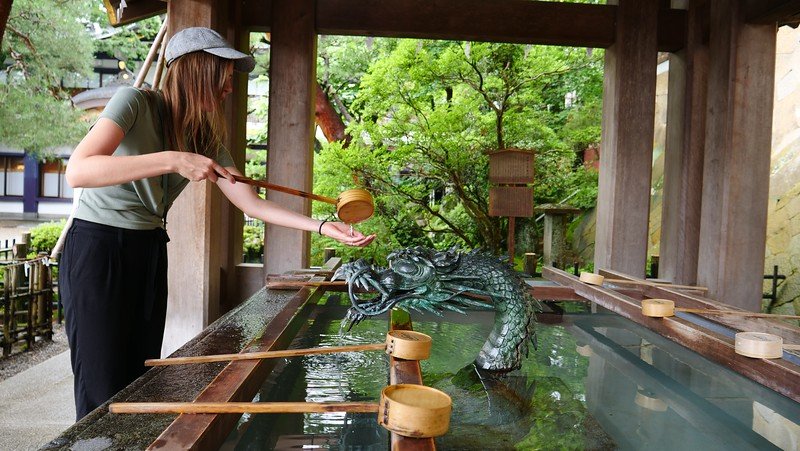
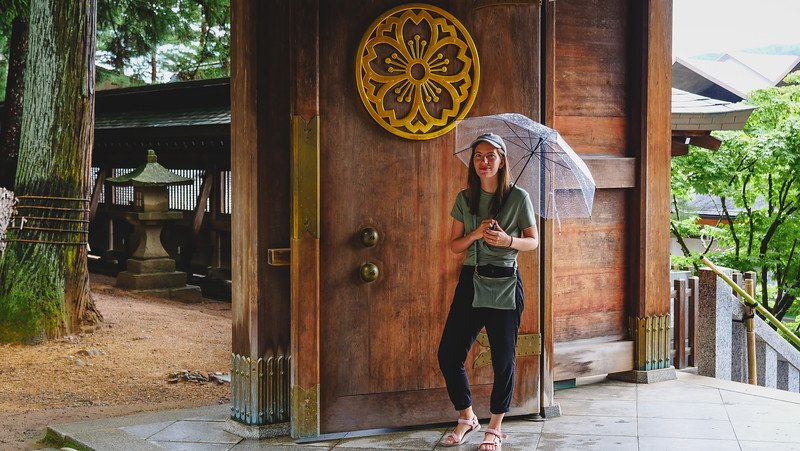
My one tip would be to consider visiting Takayama in the shoulder season – spring or summer. We were there in the summertime and it was either hot and humid or raining buckets.
To be honest, I would avoid visiting Japan in the summertime based on personal experience!
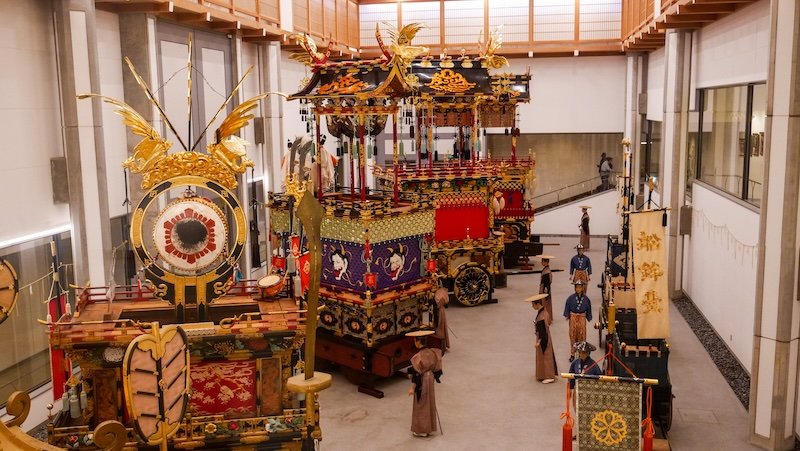
Visit the Festival Floats Exhibition Hall
The Takayama Festival Floats Exhibition Hall is dedicated to displaying the ornate floats (yatai) used in the famous Takayama Festival, which is held annually in spring and autumn and is considered one of Japan’s most beautiful festivals.
The floats are an embodiment of the region’s craftsmanship and artistic skill. They are intricately decorated and feature detailed carvings, lavish metalwork, and exquisite textiles. Each float is a masterpiece of traditional Japanese artistry, and some are even adorned with mechanized dolls (karakuri ningyo) that can move and perform during the festival.
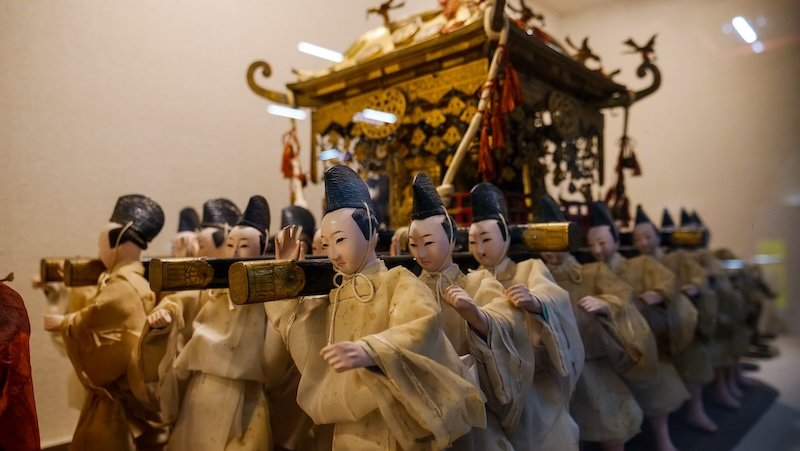
The hall houses 11 floats that are rotated 3 times a year (in March, July, and November) putting 4 on display each time.
The Takayama Festival, with its roots going back several centuries, is not only a major tourist attraction but also an important cultural event for the locals, showcasing their pride in their heritage and craftsmanship.
Try Japanese street food at the market
Takayama has two morning markets where you can enjoy some street food.
One is the Jinyamae Morning Market located in front of Takayama Jinya on the west side of the Miyagawa River; this one focuses on fresh produce with a few street snacks and souvenirs.
The other is the Miyagawa Morning Market on the east side of Miyagawa River, which begins just north of the Kaji Bridge; this one offers a larger variety of street food with a bit of produce, flowers, and souvenirs also added to the mix.
We went on our own do-it-yourself street food tour of Takayama focusing on the Miyagawa Morning Market and some of the adjacent streets.
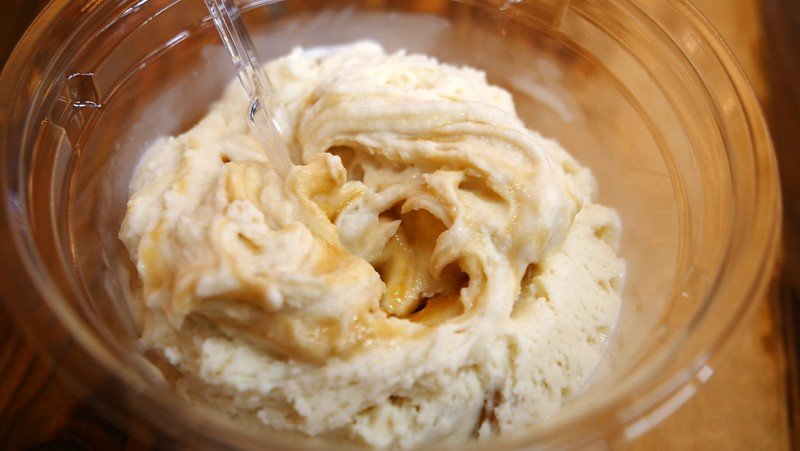
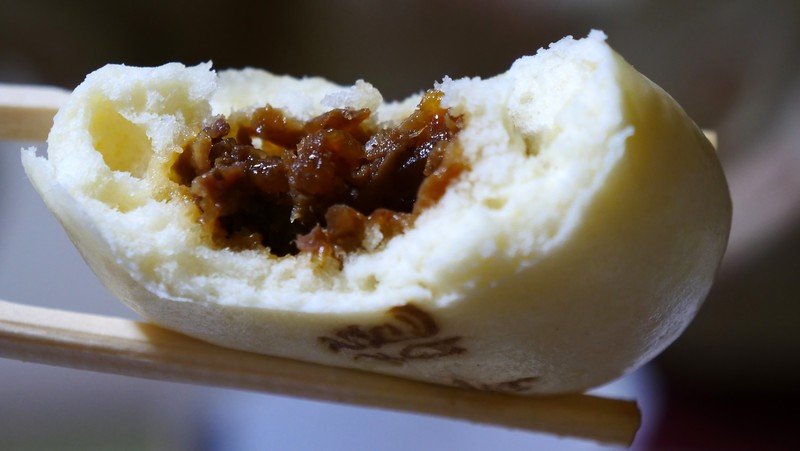
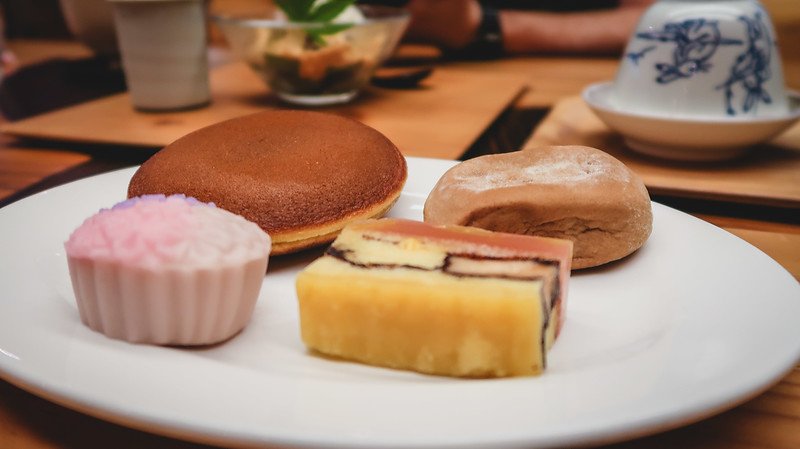
Here is a list of some of the must-try Japanese street food in Takayama:
- Chestnut Ice Cream – ¥250
- Hida Been Bun – ¥430
- Hida Beef Croquette – ¥190
- Hida Beef Skewer – ¥450
- Hida Beef Takoyaki – ¥350
- Rice Crackers – ¥120-150
- Soy Sauce Ice Cream – ¥380
- Hida Beef Nigiri – ¥700
So yes, there’s a lot of Hida beef thrown in the mix, but when in Takayama that’s what you’ve gotta try!
Try Buddhist vegetarian cuisine
One of the best things to do in Takayama for any foodies out there is to try sansai cuisine.
Sansai means “mountain vegetables” and the ingredients used in the preparation of these dishes are typically foraged not farmed.
The restaurant we ate at was listed as “Local Cuisine Hisadaya” on GoogleMaps, but the sign read “Antique” once we reached the place. We were a bit confused at first, but the photos matched the place even if the names didn’t!
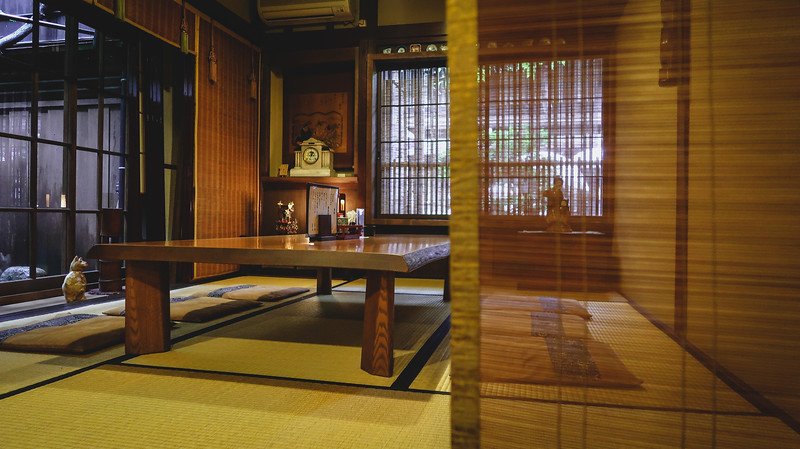
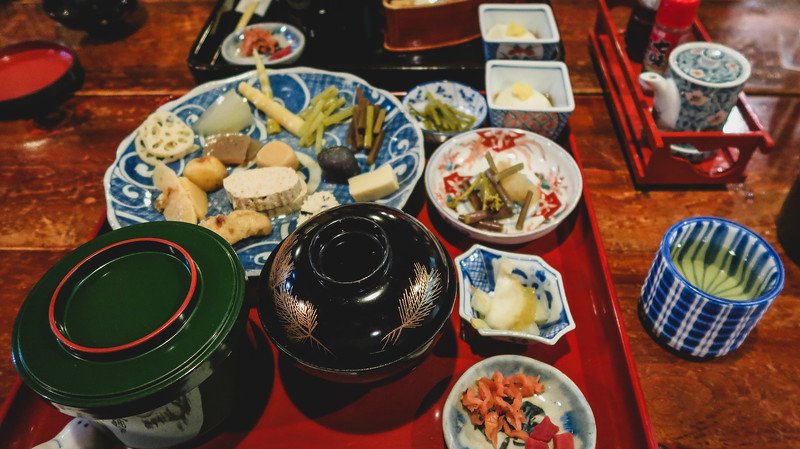

The interior was beautiful and everything you’d expect from Japan. We dined in a traditional setting with low tables and cushions, soft music playing in the background, and an exquisite array of little dishes.
We ended up ordering two kinds of sansai ryori platters which featured compartmentalized dishes with various kinds of pickled and seasoned mountain vegetables. The dishes featured wild mushrooms, tofu, pickles, radishes, water chestnuts, bamboo, roots and shoots.
Each meal also came with a bowl of rice and a cup of green tea. The only difference between the platters that Sam and I ordered was that mine was entirely vegetarian and his came with fish and meat.
When we first decided to eat at this restaurant I wondered whether “mountain vegetables” would be a substantial enough meal or whether I’d leave hungry…well, we left beyond satisfied!
The dishes may appear small, but they all add up.
Sample Takayama’s famous Hida beef
If there’s one food that Takayama is known for, it’s Hida beef. You will notice it on almost every menu!
Hida beef is the name given to beef from black-haired Japanese cattle that have been raised in the Gifu Prefecture.
What sets this beef apart is the marbling (a mesh-like fat that runs through the meat), which makes it quite tender and gives it a distinct juiciness.
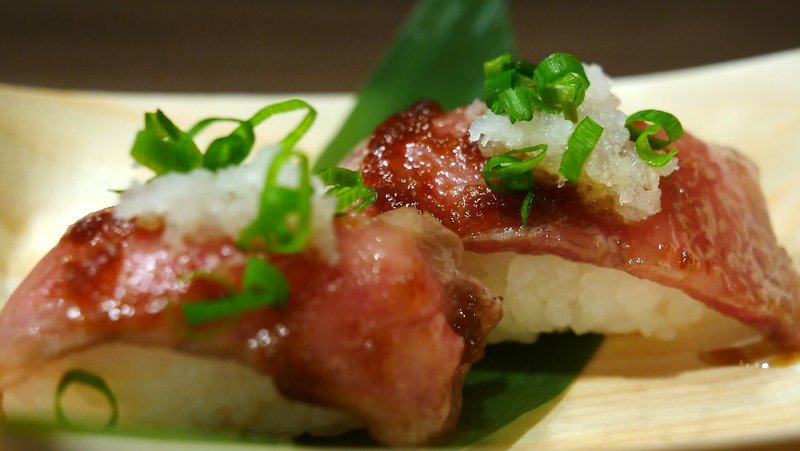
We tried Hida beef a few different ways during our visit to Takayama.
First, we had tried Hida beef sushi, also known as Hida beef nigiri, where it is served on top of rice.
The meat was lightly cooked with a torch and that melted a bit of the fatty marbling which then coated our mouths.
The Hida beef was served slightly pink (medium-rare) and we made sure to savour it.
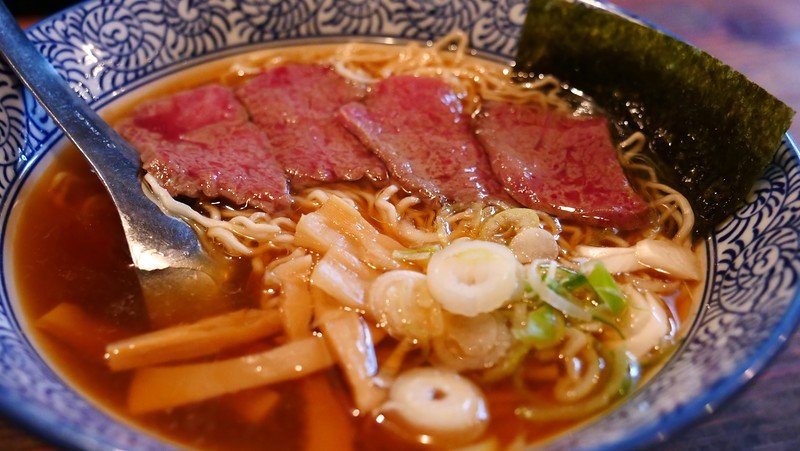
We then went to a restaurant where we tried Hida beef noodles; here we could choose between Hida beef and premium Hida beef.
The beef was served in a salty soy broth with thin Takayama noodles, bamboo shoots, scallions and dried seaweed.
The noodles in Takayama are thinner and curlier than other types of ramen you may encounter in Japan, and they’re also a bit more bouncy.
The Hida beef was very tender and the marbled fattiness was very welcome – it’s not chewy in any way, but rather it melts and adds its own unique flavour to the dish.
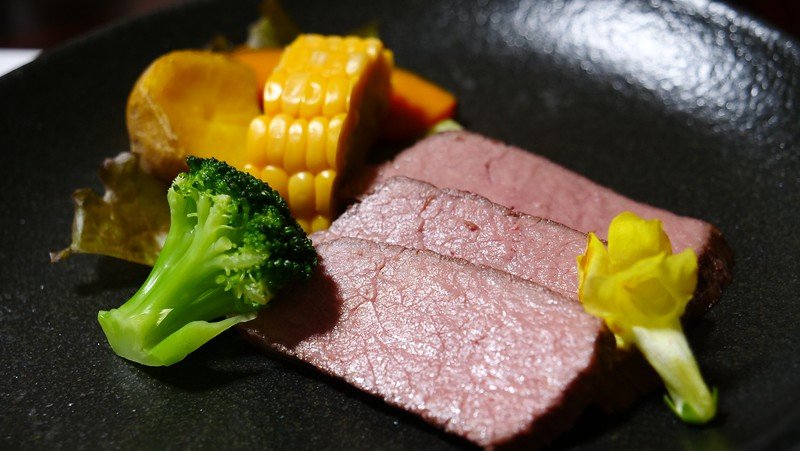
Because the ryokan where we spent the night specialized in Hida beef, we also got to try it at dinner 3 different ways.
We had Hida beef steamed buns, Hida beef shabu shabu, and lastly, Hida beef steak. Each dish was so unique and showcased the versatility of the beef.
Visit Hida Folk Village
Hida Folk Village is an open-air museum that captures the essence of traditional Japanese life. This village, known locally as Hida no Sato, consists of over 30 traditional houses that have been relocated from their original sites to create a picturesque and historically rich setting.
These buildings, some of which date back to the Edo period, represent a variety of architectural styles, including thatched and shingled roofs, showcasing the ingenuity and adaptability of rural Japanese architecture.
Visiting Hida Folk Village is stepping back in time to a bygone era. The folk village also offers demonstrations of traditional crafts so you can begin to imagine what life would have been like during that time.
Spend the night in a ryokan
Personally, I think one of the best things to do in Takayama is to treat yourself to a ryokan stay.
I’ve already written about how staying in a ryokan was one of the highlights of our trip to Japan, so it’s something I would definitely recommend doing if you can stretch your budget.
We stayed at Ryokan Seiryu and had a wonderful experience from start to finish.
A ryokan is a traditional Japanese guesthouse where you can experience Japan’s renowned hospitality, relax in an onsen, sleep on tatami floors and feast on a multi-course dinner where each dish receives the utmost attention to detail.
Staying in a ryokan allows you to experience omotenashi, which has no direct translation in English, but refers to outstanding hospitality.
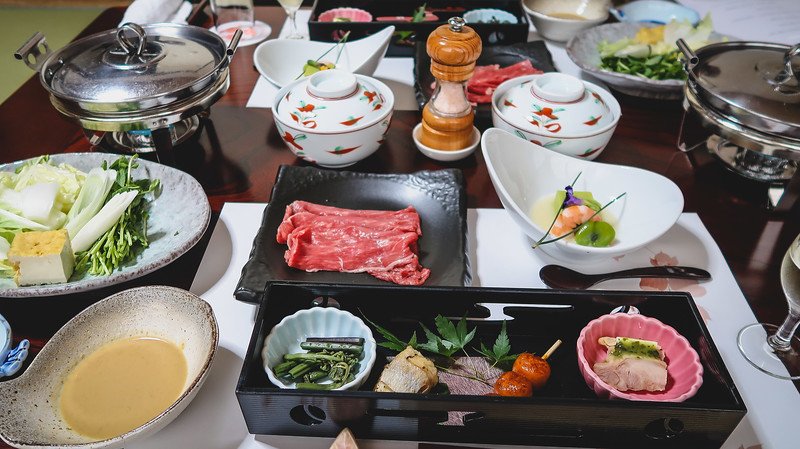
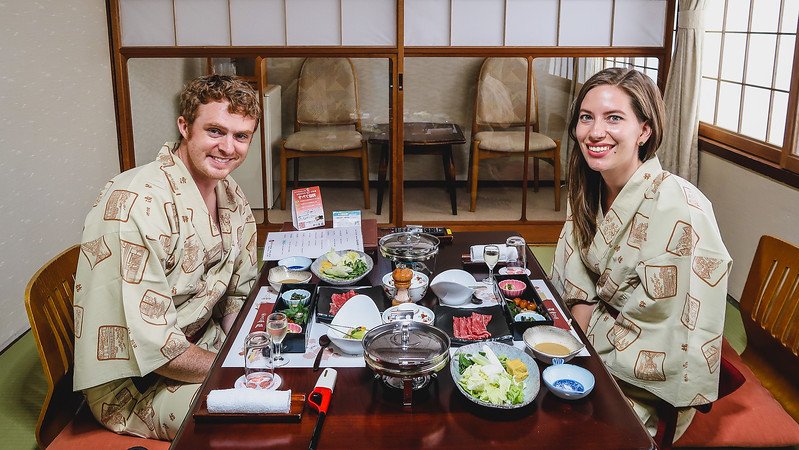
Take a day trip to Shirakawa-go
Last but not least, one of the main draws to Takayama is its proximity to Shirakawa-go.
Shirakawa-go is a small village known for its thatched-roofed farmhouses said to resemble hands clasped together in prayer.
The whole town is a UNESCO World Heritage Site and it’s really something you have to see for yourself!
The farmhouses were built out of wood and straw in an A-frame style known as gasshō-zukuri and the whole town has a magical quality to it. They reminded me of the chalets you would expect to find in Austria, Germany and Switzerland.

If you want to spend the night in Shirakawa-go, it is possible to book a farmhouse stay with a local family. You can do so through the Japanese Guest Houses website.
They only allow a 1-night stay since accommodations are in very hot demand. The website has a list of farmhouses to choose from and you are asked to select your top 3; if one of your top 3 is not available, you will be placed in a similar style of farmhouse.
And if you decide that a day trip is enough, you can view the bus timetable here.
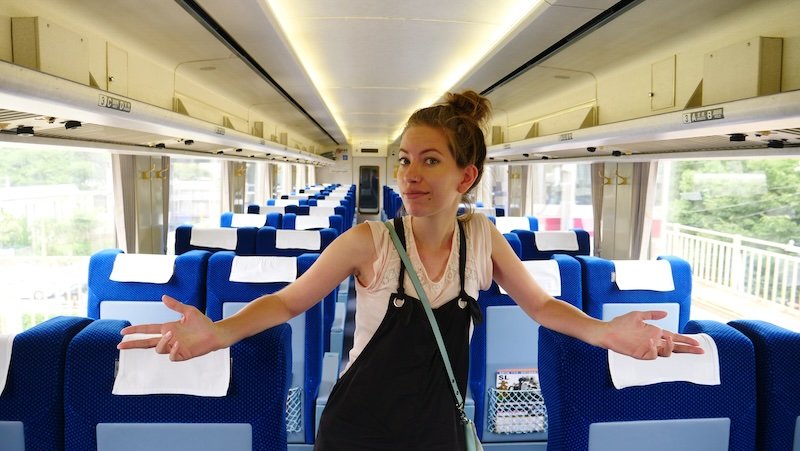
Getting to Takayama
The most common and efficient way to get to Takayama is by train arriving at Takayama Station.
For travellers coming from Tokyo, the journey typically involves taking the Shinkansen (bullet train) to Nagoya and then transferring to the JR Hida Limited Express, a scenic train ride that winds through picturesque valleys and mountains, offering breathtaking views of the Japanese countryside. From Nagoya to Takayama it takes about 2.5 hours.
Alternatively, those coming from Osaka or Kyoto can also take a train to Nagoya and then catch the JR Hida Limited Express.
For visitors preferring to drive, the roads leading to Takayama offer their own scenic charms, though travel times can be significantly longer depending on the point of origin.
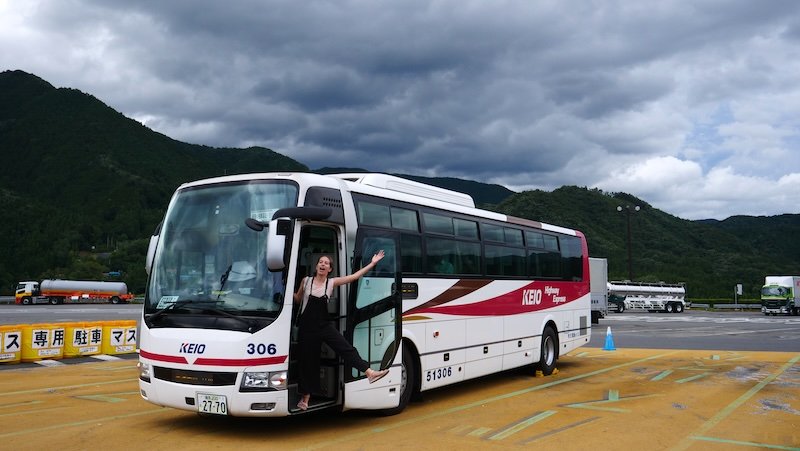
Additionally, there are bus services from various cities, including Tokyo and Nagoya, which offer a budget-friendly option, although they take longer than the train.
Regardless of the mode of transport, the journey to Takayama is part of the experience, setting the stage for the historical and cultural richness that awaits in this charming town.
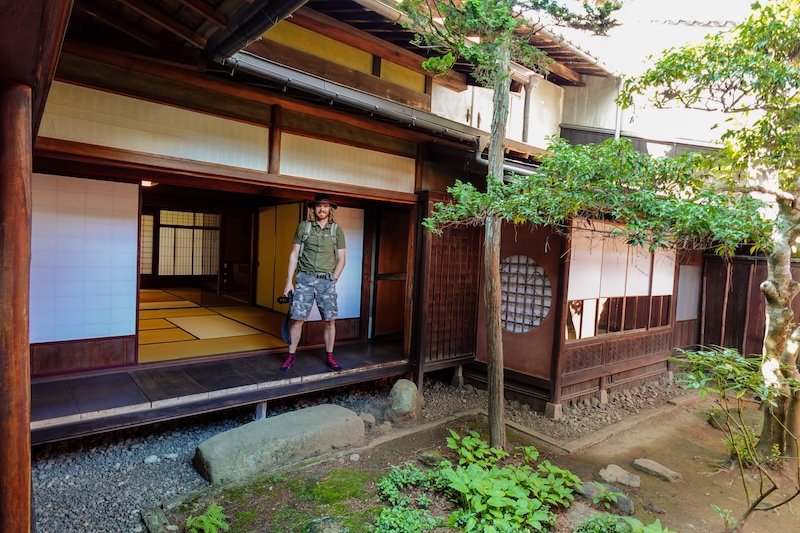
Plan Your Takayama Trip: Practical Add-On Guide, Travel Tips, Planner, Itinerary & More!
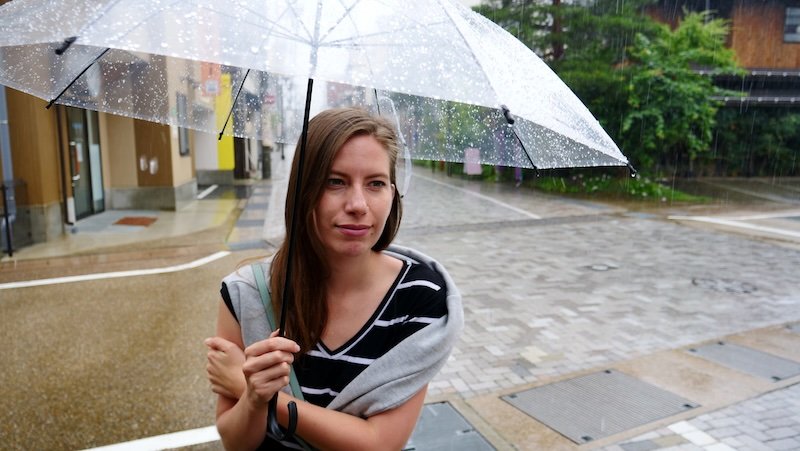
When to Visit Takayama
| Season | Weather Snapshot | Best For | Watch Outs |
|---|---|---|---|
| Spring (Apr–May) | Cool–mild; cherry blossoms in early spring | Sanmachi Suji strolls, temples, festival floats | Book ahead around the Spring Takayama Festival |
| Summer (Jun–Aug) | Warm–hot, humid; afternoon showers | River walks, markets, alpine day trips | Heat/humidity; sudden downpours—pack a light shell |
| Autumn (Oct–Nov) | Clear, cool, foliage season | Higashiyama walk under fiery leaves | Busy weekends; earlier sunsets |
| Winter (Dec–Mar) | Cold, snow possible | Onsen, ryokan stays, snowy Shirakawa-go | Icy sidewalks; check bus/train updates |
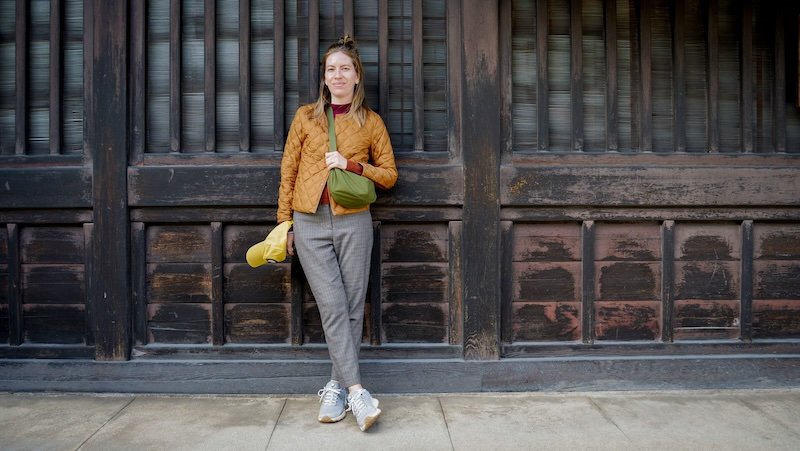
Where to Stay in Takayama (By Vibe & Convenience)
Destination Snapshot: Pick Your Base
| Place | Vibe in a Word | Best For | Ideal Stay | Don’t Miss |
|---|---|---|---|---|
| Sanmachi Suji (Old Town) | Timeless | Wooden Edo-era streets, sake breweries, cafés | 2–3 nights | Lantern-lit evening wander + small izakaya |
| Miyagawa Riverside & Morning Markets | Tasty | DIY street-food tours, easy strolls | 2–3 nights | Soy-glazed mitarashi dango at the river |
| Takayama Station Area | Practical | Rail/bus access, luggage lockers, late eats | 1–2 nights | Bento + local beer convenience for early trains |
| Higashiyama / Temple Town | Serene | Temple walks, castle ruins, quiet stays | 2 nights | Golden-hour loop on the walking course |
| Hida Folk Village Vicinity | Folk | Open-air museum, craft demos, countryside feel | 1–2 nights | Sunset over thatched rooftops |
| Okuhida Onsen (nearby) | Steamy | Rotenburo (outdoor baths), mountain views | 1 night add-on | Mixed-season hot-spring steam with snow or stars |
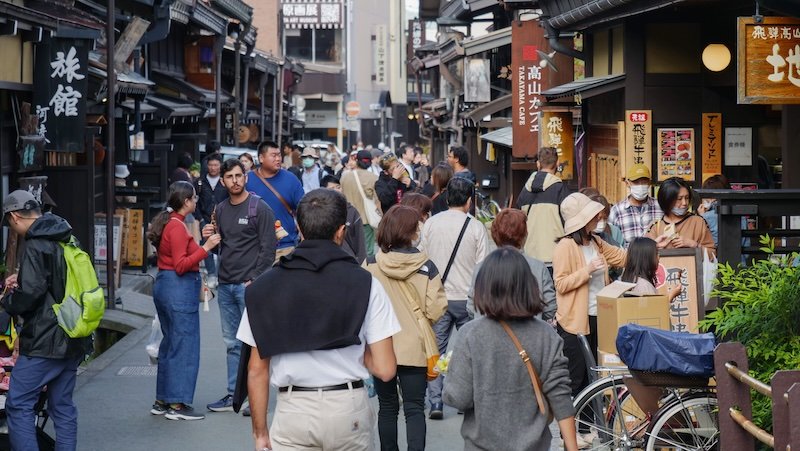
Getting to & Around Takayama (Simple & Stress-Free)
Arrivals Made Easy
- From Tokyo: Shinkansen to Nagoya, then the JR Hida Limited Express to Takayama (scenic and comfy).
- From Kyoto/Osaka: Train to Nagoya, then JR Hida; or connect via Toyama if you’re looping the Alps side.
- Buses: Direct highway buses run from Tokyo, Kanazawa, Toyama, and Nagoya—budget-friendly, a bit slower, very straightforward.
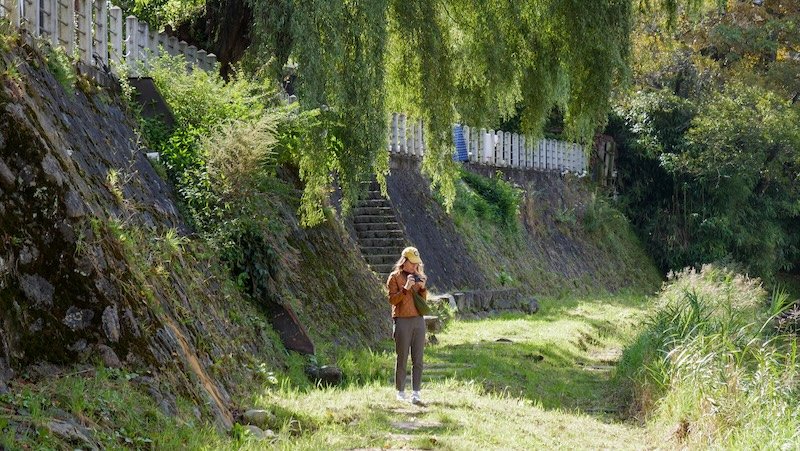
Once You’re There
- On foot: Most sights in central Takayama are walkable.
- Bikes: Many guesthouses rent bicycles (great for Hida Folk Village).
- Buses: Handy for Hida Folk Village and suburban shrines; pay as you exit.
- Luggage forwarding (takkyubin): Ship bags to your ryokan and free your hands for market grazing.
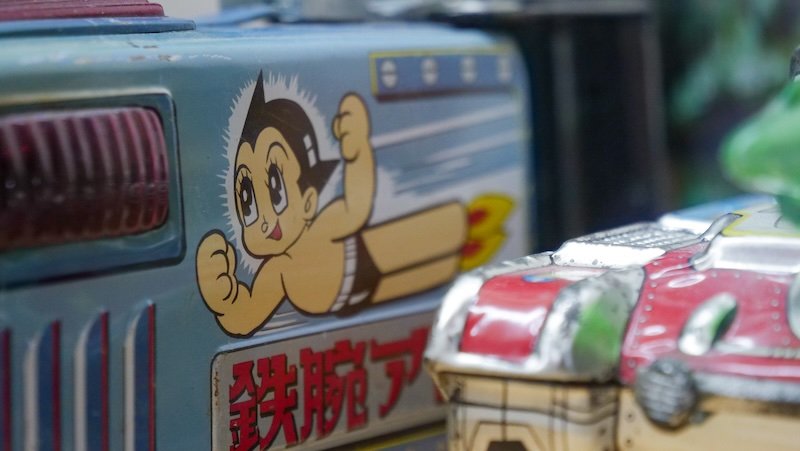
Budget Planning: What a Day May Cost
Ballparks to help you plan (per person, JPY):
| Category | Budget Stays | Mid-Range | Notes |
|---|---|---|---|
| Accommodation | ¥4,000–7,000 | ¥9,000–16,000 | Ryokan with dinner/onsen costs more but is a highlight |
| Food & Drink | ¥2,000–4,000 | ¥4,000–7,000 | Markets + noodle shops keep costs friendly; kaiseki is a splurge |
| Local Transport | ¥0–800 | ¥0–1,200 | Walk/bike for central sights; occasional bus |
| Attractions | ¥0–2,000 | ¥1,000–3,500 | Many temples free/low cost; museums ~¥500–1,000 |
| Day Trips (return) | ¥1,800–3,800 | ¥2,500–5,000 | Depends on bus route and add-on entries |
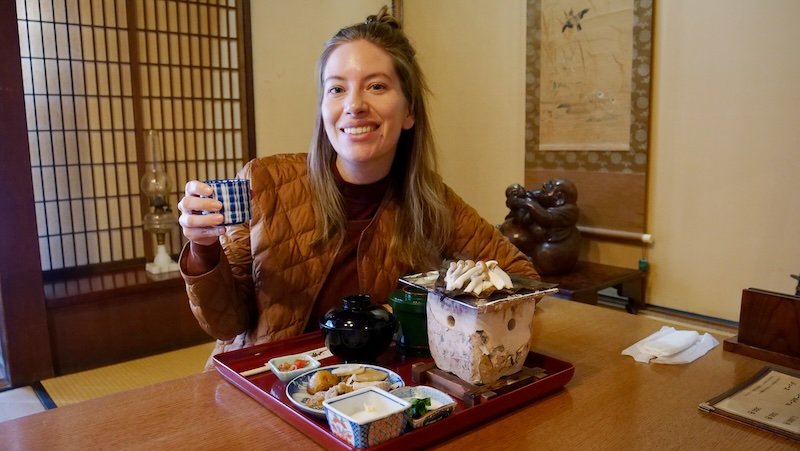
Eat & Drink: Beyond Hida Beef
Local Essentials
- Takayama Ramen (Chūka-soba): Clear soy-based broth, thin curly noodles, springy bite.
- Hoba Miso: Miso grilled on a magnolia leaf, often with mushrooms/scallions; heavenly over rice.
- Mitarashi Dango (Takayama style): Savory soy-glazed rice dumplings (less sweet than elsewhere).
- Sansai Ryōri: Foraged “mountain vegetables”—earthy, seasonal, and surprisingly filling.
- Sake Tastings: Look for sugidama (cedar ball) hanging outside breweries; it signals new sake.
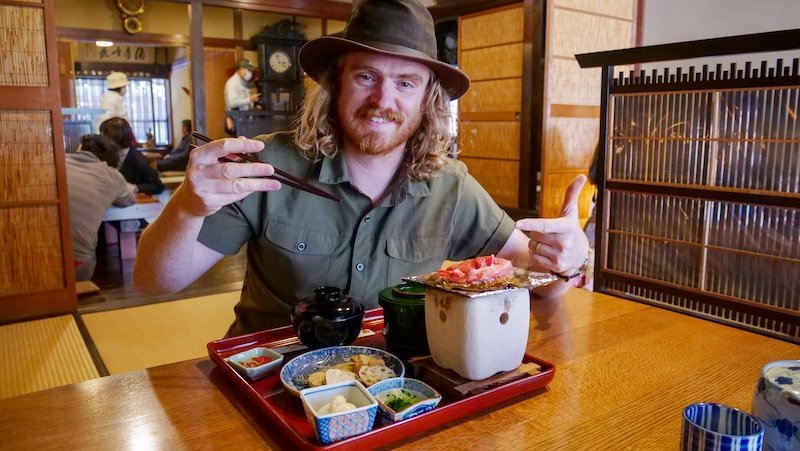
Morning Market Playbook (DIY Food Crawl)
- Start at Miyagawa Market around opening for fresh skewers and soy-glazed dango.
- Follow the river north, sampling Hida beef buns and croquettes.
- Hop across to Jinyamae Market for produce, pickles, and pantry treats to take home.
- Finish with soy sauce ice cream (yes, really) or a matcha latte.
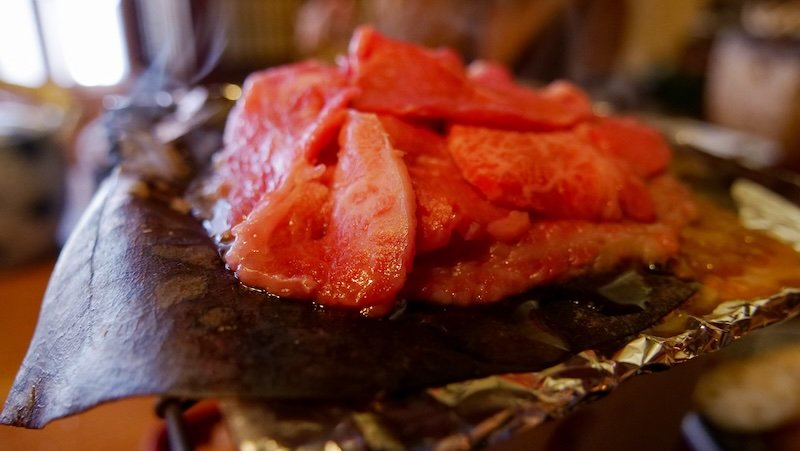
Sake & Tour Vetting
| Topic | Ask This | Green-Flag Answer Looks Like |
|---|---|---|
| Sake Brewery Tour | “Do we see production? How many tastings?” | Walkthrough with fermentation/pressing explained; 4–6 pours; water provided |
| Food Tour | “Group size? Dietary flexibility?” | ≤8 guests; can accommodate pescatarian/veg if told in advance |
| Cooking Class | “Hands-on or demo? Recipes included?” | You cook; printed or PDF recipes to take home |
| Ryokan Dinner | “Set menu? Allergies?” | Seasonal kaiseki with advance dietary notes honored |
| Shirakawa-go Excursion | “Viewpoint time? Return options?” | Guarantees lookout stop + village free time; clear bus schedule |
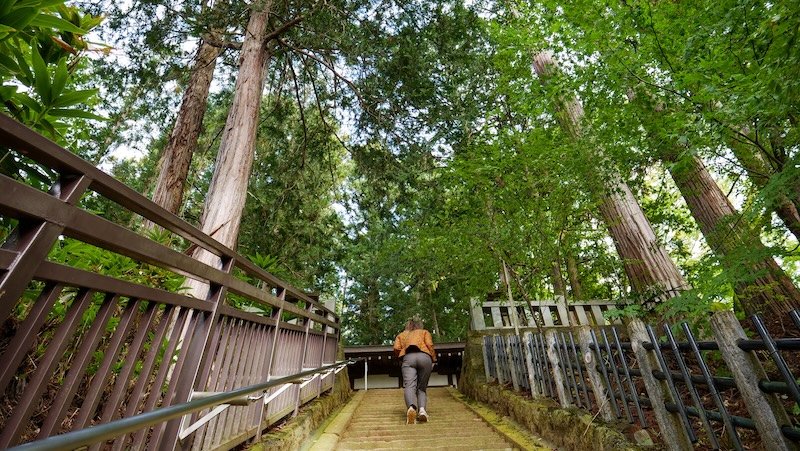
Micro-Itineraries You Can Copy
Takayama in 2 Days (Highlights)
Day 1 – Old Town & Markets
- Morning: Miyagawa Market tastings → stroll Sanmachi Suji.
- Lunch: Takayama ramen near Old Town.
- Afternoon: Sake brewery sampling; café break in a wooden townhouse.
- Evening: Golden-hour photos → Hoba miso dinner.
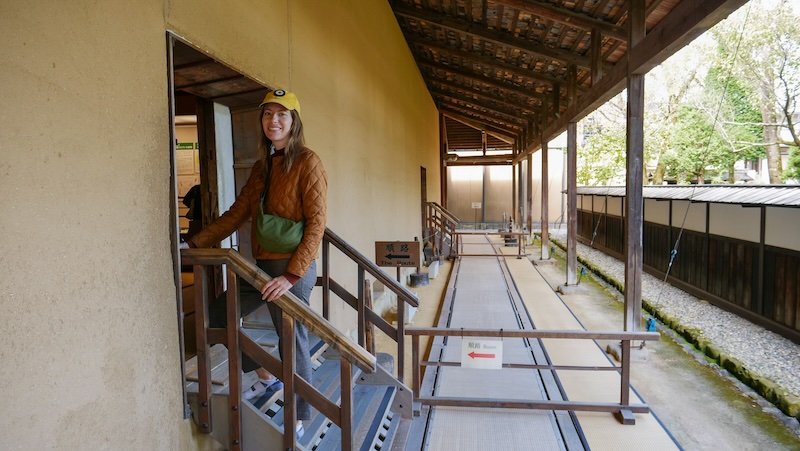
Day 2 – Temples & Folk Heritage
- Morning: Higashiyama Walking Course (temples + castle ruins).
- Lunch: Sansai ryōri platter.
- Afternoon: Hida Folk Village (open-air museum, craft demos).
- Evening: Onsen soak or foot bath; quiet streets at night.
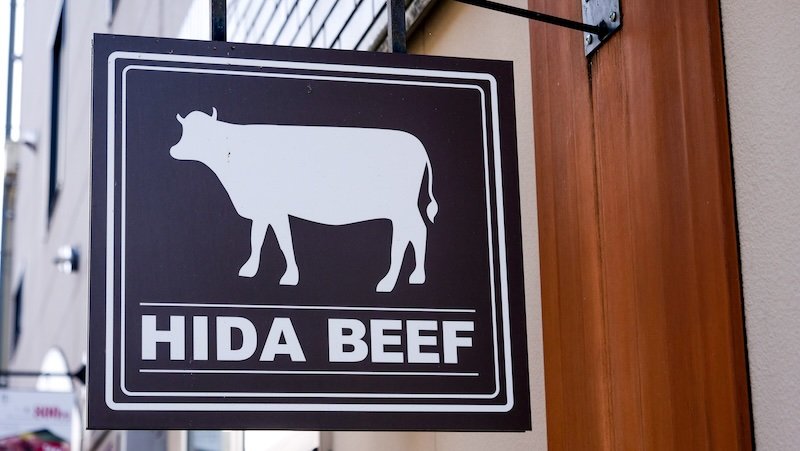
Takayama + Shirakawa-go in 3 Days
Day 1: Old Town + brewery tastings.
Day 2: Shirakawa-go day trip (early bus), A-frame farmhouses, viewpoint, return for yakitori or kushikatsu dinner.
Day 3: Higashiyama loop + Hida Folk Village by bicycle.
Slow Travel & Onsen (2 Nights + Okuhida)
Day 1: Markets, Old Town, sake.
Day 2: Bus to Okuhida Onsen; rotenburo with mountain views; ryokan dinner.
Day 3: Return to Takayama for last-minute crafts and souvenirs.

Day Trips That Fit
- Shirakawa-go: A-frame gasshō-zukuri farmhouses, riverside paths, seasonal views (snow, blossoms, green rice).
- Kamikōchi (seasonal): Alpine valley with turquoise rivers and walking trails—crystal-clear air.
- Gero Onsen: One of Japan’s classic hot-spring towns—perfect for a lazy afternoon soak.
- Gujo Hachiman: Canals, stone paths, food sample workshops (wax replicas)—charming and photogenic.
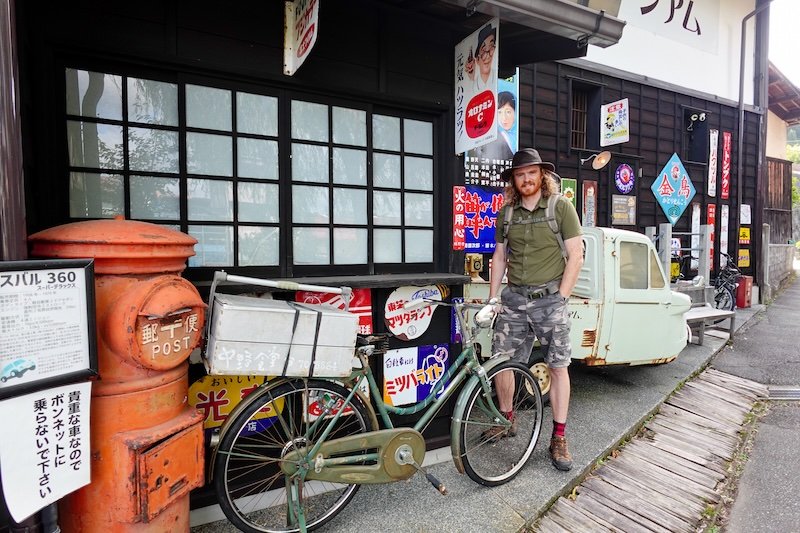
Save-This Checklist
- Choose base (Old Town for charm / Station for convenience / Higashiyama for quiet).
- Map the Higashiyama Walking Course and Sanmachi Suji in offline maps.
- Plan one guided experience (brewery, food tour, or cooking class).
- Lock Shirakawa-go bus seats (if going) and note viewpoint stop.
- Book ryokan with onsen; confirm dietary needs.
- Pack layers + compact umbrella; comfy walking shoes.
- Bring small bills/coins for markets, buses, lockers.
- List three foods to try (ramen, hoba miso, sansai set—or your picks!).
- Set one rainy-day backup and one sunset plan (Old Town or river).
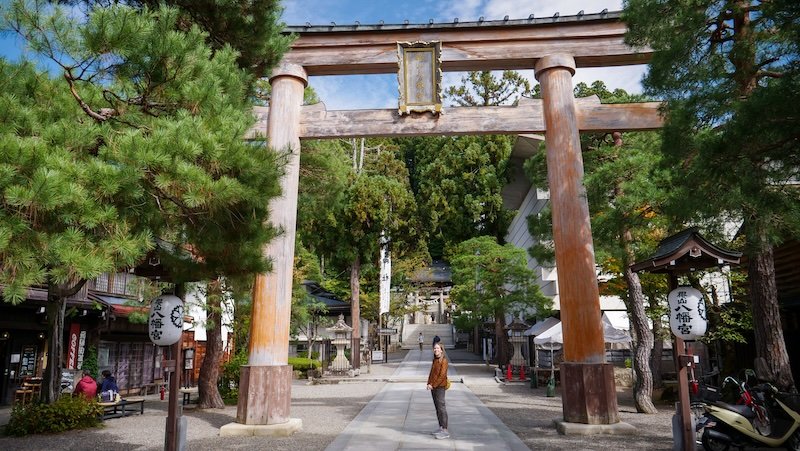
Takayama FAQ (12 Quick Answers)
- How many days do I need in Takayama?
Two full days cover Old Town, markets, and the temple walk. Add a third day for Hida Folk Village or Shirakawa-go. - Is Takayama good without a car?
Yes. The historical core is walkable, and buses cover Folk Village, Okuhida, and day trips. - Takayama or Kanazawa if I have to choose?
Kanazawa is bigger with major museums and gardens; Takayama is cozier, more intimate, and pairs beautifully with Shirakawa-go. - What’s the best area to stay for first-timers?
Within walking distance of Miyagawa Market/Sanmachi Suji—you’ll graze and wander with minimal transit. - Do I need to book restaurants?
For kaiseki at ryokan or popular Hida beef spots, reservations help. Markets and ramen shops are usually walk-in. - Are the morning markets open daily?
They run most days, with hours varying by season and stall—go early for the freshest bites and fewer crowds. - Is there vegetarian food?
Absolutely. Look for sansai ryōri (mountain vegetables), tofu dishes, and ramen with veg broths. Many places can adapt if you ask. - Can I visit Shirakawa-go in winter?
Yes, and it’s gorgeous under snow. Check bus schedules and road conditions, wear proper footwear, and expect cold. - What should I pack for shoulder seasons?
Layers, a light rain shell, warm socks for temples, and a compact umbrella. Evenings can dip in temperature. - How do I try sake responsibly?
Pick one brewery tour or tasting flight, hydrate between pours, and buy a small bottle you genuinely enjoyed. - Are there lockers for luggage?
Yes—coin lockers at Takayama Station make same-day sightseeing easy before check-in/after check-out. - What time does Takayama “shut down”?
Earlier than big cities. Plan dinners on the early side and enjoy the quiet streets after dark.

Lovely post! We’re planning to go to Takayama soon. Would you mind sharing the name of the ryokan where you stayed?